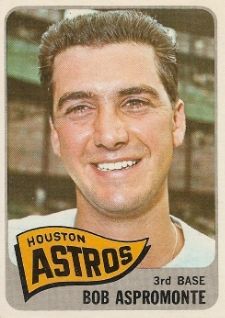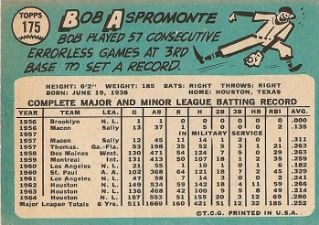
Right. So I had a grand, heartfelt farewell address written for this, the last card to be posted to The Great 1965 Topps Project. Then I actually doubled back to update
the Checklist page, and...there are 12 cards that I have in my possession that I've never scanned, written up, and posted to the blog. You'll have me to kick around for at least another month. Whoops! Still, this IS the last pesky high-series rookie card, courtesy of Max. It features one big league mainstay, two role players, and a cup-of-coffee guy. We've done worse with Rookie Stars player selection. So here goes.
Fun facts about Jim Lonborg:
-Jim was born in Santa Maria, CA, and signed with the Red Sox in 1963 after earning a biology degree at Stanford University.
-His high school teammate and good friend Mel Queen went on to pitch for the Reds and Angels, and also married Lonborg's sister.
-Jim jumped to the major leagues at age 23 in 1965 and took his lumps, putting up a 9-17 record and a 4.47 ERA.
-Lonborg came of age in Boston's 1967 "Impossible Dream" season, going 22-9 with a 3.16 ERA to tie former teammate Earl Wilson for the American League lead in wins. He also led the loop with 246 strikeouts en route to his lone All-Star berth, a sixth-place finish in MVP voting, and a near-unanimous selection as AL Cy Young Award winner.
-He pitched to a 2.63 ERA in three starts in the 1967 World Series, shutting out the Cardinals in
Game Two and outlasting Steve Carlton in
Game Five before running out of gas in the decisive
Game Seven.
-An offseason skiing accident in the winter of 1967-1968 caused severe ligament damage in Jim's left knee. He tried to rush back from surgery and wound up damaging his rotator cuff while compensating for the knee; he would never be as effective as he had been before these injuries.
-He was sent to Milwaukee in a 10-player deal after the 1971 season. After a solid year with the Brewers (14-12, 2.83 ERA, 107 ERA+), the righty was traded to the Phillies, this time in a seven-man swap. He would remain with Philly throughout the decade, winning 75 games in six-plus seasons and appearing in the NLCS in both 1976 and 1977.
-In parts of 15 seasons, "Lonnie" was 157-137 with a 3.86 ERA. He was selected to the Red Sox Hall of Fame in 2002.
-After hanging up his spikes, Jim matriculated from Tufts University Dental School. He has had his own dental practice in Hanover, MA since the mid-1980s.
-
According to comedy writer and former baseball announcer Ken Levine, the photo of "Sam Malone" that hung above the bar on the popular sitcom "Cheers" was actually a photo of Lonborg. The character (played by Ted Danson) was a former Red Sox pitcher.
Fun facts about Mike Ryan:
-Haverhill, MA native Mike Ryan grew up as a Red Sox fan, then signed with the team as a teenager in 1960.
-After four years as a light-hitting, defensively-adept catcher in the Boston farm system, Mike got a one-game cup of coffee on
October 3, 1964, going 1-for-3 with a two-run single and an intentional walk in a 7-0 Sox victory.
-Though Ryan hit just .159 in 33 games in 1965, he had two home runs at Tiger Stadium on
May 2, 1965. It was only his second big league game; there would be 634 more, but never again did he homer twice in a game.
-He was traded to the Phillies prior to the 1968 season. As the team's primary catcher in 1969, Mike hit a career-best 12 home runs and drove in 44, but still had just a .204 batting average.
-Every dog has his day: Mike hit home runs off of Hall of Famers Juan Marichal and Tom Seaver in 1969.
-Tim McCarver's arrival in Philadelphia pushed Ryan back to the bench, where he remained through the 1973 season. He was dealt to Pittsburgh in 1974, appeared in only 15 games, and retired at age 32.
-In parts of 11 seasons, Mike batted .193 with 28 home runs and 161 RBI. He also had a .991 fielding percentage and threw out 44% of would-be base stealers.
-Of all position players since 1930, only shortstop Ray Oyler (.175) had a lower batting average with at least 1,000 career at-bats than Ryan.
-He was a minor-league manager in the Pirates (1975-1976) and Phillies (1977-1978) organizations before becoming the Phils' major league bullpen coach in 1980, a position he held until retiring from the game in 1995.
-Mike lives with Suzanne, his wife of more than 40 years, in Wolfeboro, NH.
Fun facts about Bill Schlesinger:
-Bill was born in Cincinnati, OH, the son of a hardware store owner. During his childhood, several Reds players worked for his father in the offseason, including Gus Bell, Johnny Temple, Ted Kluszewski, and Roy McMillan.
-He actually never played organized baseball growing up, as he failed to make the cut both in high school and in college at the University of Cincinnati. However, his father's connections proved valuable, as Red Sox scout Denny Galehouse took a flyer on Schlesinger for a $1,000 signing bonus in 1963.
-Incredibly, Bill not only made the cut with Boston's New York/Penn League team in Wellsville, NY, but was named a league All-Star. His resume included a .341 average, a .624 slugging percentage, 31 doubles, and league-leading totals of 129 runs scored and 37 home runs. He even stole 18 bases.
-The Red Sox invited him to major league camp in 1965, and he went north with the team. He suspects that he was chosen over Jerry Moses because the latter was a more highly-regarded prospect and the team did not want to hinder his development.
-Indeed, the BoSox did not use Schlesinger in a game until
May 4, 1965. He pinch hit for pitcher Dave Morehead leading off the sixth inning, and tapped a comebacker to Angels hurler Marcelino Lopez, who threw him out at first base. In his
SABR biography, the player offers an amusing retelling of this experience, complete with a wipeout on the dugout steps and a weighted donut that would not come off of his bat.
-He had no way of knowing at the time, but that one inauspicious at-bat was to be Bill's lone major league experience. He was placed on waivers three days later and claimed by the Athletics.
-The outfielder wound up back in Boston's farm system twice more in his career. He also played in the Cubs and Phillies organizations.
-In August of 1969, Bill was to be promoted to the major leagues by the Phillies, but was hit in the face by a Larry Sherry pitch while still at AAA. He couldn't see at all for a few days afterward, and ultimately lost 40% of his vision. He finally retired in the spring of 1971 after the Pirates sent him home from their camp.
-He returned home to Cincinnati and inherited Pleasant Ridge Hardware when his father passed away in 1972.
-Bill ended up playing slow-pitch softball for 25 years, and is in the Greater Cincinnati Softball Hall of Fame.
Fun facts about Jerry Moses:
-A native of Yazoo City, MS, Jerry turned down a football scholarship from Bear Bryant at the University of Alabama and signed with the Red Sox for a $50,000 bonus in 1964.
-His father Sammy was a baseball scout for 25 years, working for the Pirates, Angels, and Dodgers.
-Bonus baby rules did force Boston to put Moses on the big league roster for three months in 1965. He had just four pinch-hit appearances all year, but the second of those came on
May 25, 1965. That day, the rookie hit a booming home run off of Minnesota's Jim "Mudcat" Grant, who would win 21 games that season.
-After a six-game September cameo in 1968, Jerry shared catching duties in Beantown in 1969. In 53 games he hit .304 with 4 home runs and 17 RBI.
-His only career grand slam was the decisive blow in a 9-4 win over the Indians on
April 20, 1969. The young catcher later doubled in an insurance run to give him a career-best 5 RBI on the day.
-He hit .278 with 14 doubles, 3 homers, and 23 RBI in the first half of the 1970 season to earn an All-Star nod. The catcher would finish with career highs of 92 games played, 18 doubles, 6 home runs, and 35 RBI while batting .263.
-The Red Sox traded Moses to the Angels in October of 1970, and he played for seven teams over the final six years of his career. The others were the Indians, Yankees, Tigers, Padres, and White Sox. In between, he was also the property of the Mets for a few months.
-Jerry retired after the White Sox released him in late 1975, looking for more economic security than a backup catcher could get in those days. In parts of nine seasons, he batted .251 with 25 home runs and 109 RBI.
-Though Moses hit only 25 career homers, he victimized two pitchers twice, and both were famous for giving up moon shots: Al Downing (who served up Hank Aaron's 715th in 1974) and Hall of Famer Bert Blyleven (who set a single-season record by surrendering 50 HR in 1986).
-These days, Jerry enjoys golfing, coaching, watching the New England Patriots, and spending time with his six grandchildren.














